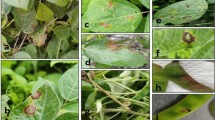Abstract
Aerobiological investigations were carried out over wheat (Triticum aestivum L.) fields near Barrackpore, West Bengal, India for two consecutive crop seasons. In 1990–91, except for the very seedling stage there was a more or less uniform spore count up to the maximum vegetative growth stage and from flowering onwards, a gradual increase in total cfus was observed with the peak (331 CFUs) during the harvesting stage. In the second season, similar results were recorded where peak spore load (2064 CFUs) in the air was during harvesting operation followed by a sudden decline in the empty field.Cladosporium spp. dominated both the seasons mainly up to February.Penicillium, Curvularia, Aspergillus andCephalosporium were the most frequent non-pathogenic fungal types. Among the pathogenic fungi,Alternaria andDrechslera were recorded to be the most virulent to wheat crop, after inflorescence to later stages in both the seasons causing heavy leaf damage producing necrotic spots during which peak cfus were found.Fusarium was frequently found showing the peak during vegetative growth period.Sclerotium was more common in the second season than in the first season. High occurrence ofNigrospora was recorded in the earlier stages. ‘Sterile forms’ were found regularly. The phylloplane studies revealed thatCladosporium was the most dominant flora contributing 40–66% up to February in winter; gradually disappeared from the leaf surface with the onset of summer.Aspergillus andPenicillium showed the reverse picture. WhileCurvularia was isolated in high amount during later stages;Nigrospora mainly during the vegetative growth stages.Alternaria (caused Alternaria blight) andDrechslera were significantly isolated during harvesting (28.08%) and at late ‘grain maturation’ stage (80.10%), respectively.Sclerotium and ‘Sterile forms’ were recorded regularly unlikeFusarium andHelminthosporium.
Similar content being viewed by others
References
Abdel-Hafez, S.I.I. (1981) Phyllosphere and phylloplane fungi of wheat cultivated in Saudi Arabia. Mycopathologia 75, 33–38.
Abdel-Wahab, A.M. (1975) Phyllosphere microflora of some Egyptian plants. Folia Microbiol. 20, 236–245.
Agashe, S.N., Philip, E. and Meundi, M. (1992) Intramural aerobiological studies in relation to allergy. Indian J. Aerobiol. Special Volume, 153–160.
Bowen, K.L., Hagan, A.K. and Weeks, R. (1992) Seven years ofSclerotium rolfsii in peanut fields: yield losses and means of minimization. Plant Dis. 76, 982–985.
Burge, H.P., Boise, J.R., Solomon, W.R. and Bandera, E. (1978) Fungi in libraries: an aerometric survey. Mycopathologia 64, 67–72.
Calvo, M.A., Guarro, J., Suarez, G. and Ramirez, C. (1980) Airborne fungi in the air of Barcelona (Spain). III. The genus Aspergillus link. Mycopathologia 71, 41–43.
Chakraverty, R. and Uddin, N. (1995) A systematic study of leaf surface mycoflora of paddy cultivated in West Bengal. Indian Phytopathol. (in press).
Chanda, S. (1992) Aerobiology: an inter- and multidisciplinary approach. Indian J. Aerobiol. Special Volume. 1–10.
Chandel, D.S. and Chandel, U. (1993) Comparative incidence of aero-phyllo-mycoflora over soybean (Glycine max (L.) Merr.) in polluted and unpolluted localities. Indian J. Aerobiol. 6, 26–32.
Cunningham, D.D. (1873) Microscopic Examination of Air. Government Printers, Calcutta.
Dickinson, C.H. (1967) Fungal colonisation ofPisum leaves. Can. J. Bot. 45, 915–927.
Haware, M.P. (1971) Assessment of losses due to early blight (Alternaria solani) of potato. Mycopathol. Mycol. Appl. 43, 341–342.
Kuter, G.A. (1986) Microfungal populalions associated with the decomposition of sugar maple leaf litter. Mycologia 78, 114–126.
Mazen, M.B., Abdel-Hafez, S.I.I. and Shaban, G.M.M. (1984) Survey on the mycoflora of Egyptian wheat grains and their lemmae and paleae. Mycopathologia 85, 155–159.
McLean, M.A. and Sutton, J.C. (1992) Mycoflora of strawberry in Ontario. Can. J. Bot. 70, 846–852.
Morgan-Jones, G. and McKemy, J.M. (1992) Studies in the genusCladosporium sensu lato. VI. ConcerningCladosporium vignae causal organism of leaf and pod spot of cowpea (Vigna unguiculata) and leaf blight ofLespedeza bicolor. Mycotaxon 43, 9–20.
Pandit, T. and Singh, A.B. (1992) Prevalence of airborne fungi in a sugar factory environment. Indian J. Aerobiol. Special Volume, 145–152.
Papavassiliou, J.T. and Bartzokas, C.A. (1975) The atmospheric fungal flora of the Athens Metropolitan area. Mycopathologia 57, 31–34.
Prasada, R. and Prabhu, A.S. (1962) Leaf blight of wheat caused by a new species ofAlternaria. Indian Phytopathol. 15, 292–293.
Pugh, G.J.F. and Mulder, J. (1971) Mycoflora associated withTypha latifolia. Trans. Br. Mycol. Soc. 57, 273–282.
Raha, S. and Bhattacharya, K.N. (1992) Studies on indoor and outdoor aeromycoflora of Santiniketan with reference to respiratory allergy. Indian J. Aerobiol. Special Volume, 171–178.
Ruscoe, Q.W. (1971) Mycoflora of living and dead leaves ofNothofagus truncata. Trans. Br. Mycol. Soc. 56, 463–474.
Satheesh, R., Rao, G.R. and Nair, P.K.K. (1993) Incidence of airborne pollen and spores in the atmosphere of Tiruchirapalli. Indian J. Aerobiol. 6, 1–9.
Sharma, A.K. and Gupta, J.S. (1985) A comparative study of airspora and phylloplane mycoflora of yellow sarson and taramira. Indian Phytopathol. 38, 170–171.
Singh, S.R. and Singh, N.I. (1992) Aerobiology and epidemiology of rust of broad bean (Vicia faba L.). II. Role of interculture practices in the release of uredospores ofUromyces fabae. Indian J. Aerobiol. Special Volume, 133–136.
Singh, N.I., Singh, S.B. and Devi, G.A. (1992) Aerobiology and crop diseases in Manipur. IV. Fungal airspora over a sugarcane field in Imphal district. Indian J. Aerobiol. Special Volume, 137–140.
Uddin, N. and Chakraverty, R. (1994) Airborne fungal load in agricultural environment during threshing operations. Mycopathologia 127, 145–149.
Uddin, N. and Chakraverty, R. (1995) Airspora measured in a paddy field in West Bengal, India. Grana 34, 345–349.
Vardavakis, E. (1988) Seasonal fluctuation of nonparasitic mycoflora associated with living leaves ofCistus incanus. Arbutus unedo andQuereus coccifera. Mycologia 80, 200–210.
Youssef, Y.A. and Karam El-Din, A. (1988) Airborne spores of opportunistic fungi in the atmosphere of Cairo, Egypt. II. Yeast fungi. Grana 27, 247–250.
Author information
Authors and Affiliations
Rights and permissions
About this article
Cite this article
Uddin, N., Chakraverty, R. Pathogenic and non-pathogenic mycoflora in the air and phylloplane ofTriticum aestivum L. Aerobiologia 12, 257–268 (1996). https://doi.org/10.1007/BF02248162
Received:
Revised:
Accepted:
Issue Date:
DOI: https://doi.org/10.1007/BF02248162




